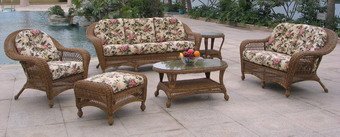An Interesting History of Furniture Manufacturers Cebu
It’s only right perhaps that furniture manufacturers Cebu can trace their beginnings to an American, the U.S. being considered its top export market.
An American oil executive, who didn’t really like being in the oil business, made friends with Dona Maria Aboitiz who had a small backyard rattan furniture shop.
Being good with his hands, he was drawn to the shop and became fascinated with the strength and flexibility of rattan as they were being handcrafted into furniture by the skilled workers in the shop.
It was John McGuire who thought of a way to give justice to the material in its design and execution when he was presented with an opportunity to deal in the rattan business.

Having married and settled back in the US, he and his wife decided to work as a team and founded the McGuire Furniture Co. in 1948. This was after they had peddled a warehouse full of rattan furniture and learned these were being bought only for sun porches.
He thought the material deserved better treatment and remembered Dona Maria and her shop. When they sent her a design she thought was not feasible, John didn’t give up. Instead, he remembered what they used to do in those cowboy movies about wet cowhide, that when dry, starts to tighten around the neck.
This breakthrough not only solved the problem of strength through cowhide but also revolutionized rattan furniture design and to this day, this combination of rattan and cowhide is a McGuire exclusive trademark with international patents.
McGuire’s real break came when they were able to persuade the famous interior designer of Gump’s in San Francisco, Eleanor Forbes, to design furniture using rattan. All of her 15 designs sold, 2 of which are considered classics and displayed at the Museum of Modern Art in New York.. By the 1950’s, the McGuire collection had not only expanded from chairs to sofas, tables and bar stools but also, a new design created a sensation every year. As their fame and clientele kept growing, they opened 21 showrooms in key US cities and engaged a distributor for the European and Japanese markets.
With the growth and expansion of the McGuire Co. Dona Maria’s Mehitabel Furniture Company in Cebu, being the McGuire’s sole manufacturer and supplier, likewise grew. She had to have subcontractors who could also meet her own strict requirements as well as the high standards set out by McGuire. Thus, enter Mr. Guillermo Figueroa, proprietor of Rattan Arts and along with a certain Mr. Nazareno, of Rattan Pacifica from Cavite, eventually became regular suppliers. Rattan Arts also had its share of fame and fortune. They had furnished posh hotels that hosted international events such as the Meeting of World Leaders in Hotel Cancun in Mexico and the Miss Universe pageant in Hotel Pereus in Greece. Like Mehitabel, it is still going strong to date and same as Mehitabel too, they have sister companies which focuses on wooden furniture products, based on market demands.
Another key player during the early developments of the Cebu furniture industry is the late Florentino Atillo. He learned the ropes of the rattan furniture trade in Dona Maria’s shop and later ventured out on his own, eventually founding the Rattan & Wood Industries, Inc. This became one of the biggest factories during its time. When he died in 1969, his wife and two sons took over the business but they later sold out. However, one son put up his own FLA III, which is also within the furniture industry.
A footnote to this was the entry of buri furniture during the 1960’s, the very first designs of which were done by Elinor McGuire, John’s wife. The top department stores bought and sold the items but unfortunately, the owners of these products left them out during winter. Thus they did not last and the disappointed owners returned them to the stores, prompting the McGuires to give up on the new material. Towards the end of 1969, Dona Maria, with another American, designed a knock down buri chair. With the right marketing strategy and innovative designs, it made its re-entry into the US market. It became very popular prompting many to go into its production. This made the product too inexpensive and the market too competitive, that it had nowhere else to go but bow out of the export market.

Many have since then joined the industry, although the threat of extinction hung over their heads many years back (early 70’s) when the sourcing of raw materials became very difficult. Cebu was the seat of production yet it didn’t have any rattan plantations at all nor any forest covers. The five rattan suppliers, Mindanao Ratan, Standard Rattan, Alenter, Pacific Traders and Norkis Trading preferred to export the raw poles rather than supply the locals.
The active lobbying by the industry members who have organized themselves into a cohesive group, the Chamber of Furniture Industries of the Philippines (Cebu Furniture Industry Foundation, CFIF) resulted in a rattan poles export ban in 1976 and the five suppliers converted to become manufacturers themselves and even became some of the biggest in the industry. Doubling exports and the resulting rash of new factories put up and numerous subcontractors again threatened the industry. Indonesia came in as a supplier but imported poles were more expensive so again, there were factories which were forced to close. Fortunately, an Englishman, Paul Maitland-Smith decided to establish a factory in Cebu. The players in the industry consider this fateful decision as one of the reasons for the beginning of the “renaissance of the industry”. The other reason is, of course, the creativity of the Cebuano entrepreneurs.


